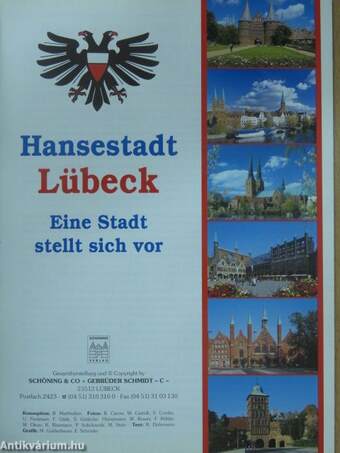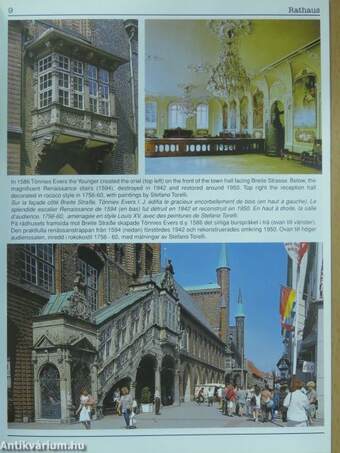1.067.308
kiadvánnyal nyújtjuk Magyarország legnagyobb antikvár könyv-kínálatát

VISSZA
A TETEJÉRE
JAVASLATOKÉszre-
vételek
Hansestadt Lübeck
Eine Stadt stellt sich vor
| Kiadó: | Schöning & Co. + Gebrüder Schmidt |
|---|---|
| Kiadás helye: | Lübeck |
| Kiadás éve: | |
| Kötés típusa: | Tűzött kötés |
| Oldalszám: | 32 oldal |
| Sorozatcím: | |
| Kötetszám: | |
| Nyelv: | Angol Francia Svéd |
| Méret: | 21 cm x 15 cm |
| ISBN: | |
| Megjegyzés: | Színes fotókkal gazdagon illusztrált album. |
naponta értesítjük a beérkező friss
kiadványokról
naponta értesítjük a beérkező friss
kiadványokról
Előszó
Hansestadt Lübeck
A glance at Lübeck's history
The Hanseatic town of Lübeck, in old times referred to as "Queen of the Hanseatic League
and the Baltic Sea", is still the biggest Baltic port in... Tovább
Előszó
Hansestadt Lübeck
A glance at Lübeck's history
The Hanseatic town of Lübeck, in old times referred to as "Queen of the Hanseatic League
and the Baltic Sea", is still the biggest Baltic port in the Federal Republic of Germany. It is
situated on the river Trave which flows into the Lübeck Bay near Travemünde. Lübeck has a
population of about 218.000 inhabitants and covers an area of 214.14 square kilometers at
an average height of 11 m above sea level.
Predecessor of present-day Lübeck was a place called Liubice, lying at the mouth of the
Schwartau, a tributary of the Trave. Liubice was first recordet at the time of Gottschalk, a Chri-
stian prince of the Wendian tribe, and was laid waste during a war in 1138.
In 1143, Count Adolf II of Schauenburg founded a merchants settlement on a hill between the
river Trave and the Wakenitz, to open up trade in the Baltic region. When this colony was
destroyed by fire in 1157, Duke Henry the Lion founded the township of Lübeck in 1159 for
the same purpose. He gave his full attention to the new community, granting it township
rights and a constitution. In 1160, he moved the bishop's seat from Oldenburg to Lübeck an
laid the foundation stone of the cathedral in 1173. Emporer Frederick II of the Hohenstaufen
dynasty, bestowed on Lübeck the status of a free city in 1226.
In the middle of the 14th century, Lübeck assumed leadership of the German Hanseatic
League, which in its prime, comprised 200 townships. The last assembly of the Hanseatic
cities was held in Lübeck in 1630 in traditional manner - henceforth, only Hamburg, Lübeck
and Bremen have retained the prefix "Hansestadt" (Hanse-town). A last attempt in 1669,
aimed at the revival of the Hanseatic League, failed although Cologne, Danzig and Bruns-
wick had participated, and other cities had also declared their interest.
During the course of its dramatic history, Lübeck has not only experienced many military
conflicts, but also periods of great prosperity. It was during the latter that many significant
monuments, public buildings, churches, merchant houses and charitable institutions were
built. A large number of these have been preserved or restored.
In 1937, the "Greater Hamburg Edict" removed Lübeck's imperial privilege as a free city after
a period of 711 years, and it was annexed to the Prussion province of Schleswig-Holstein.
On March 29th 1942, the night before Palm Sunday, Lübeck was the target of the first
bomb-attack on a German city, and about one fifth of the old town was destroyed.
At the end of the war, the city absorbed some 90.000 exiles and refugees from the eastern
regions of Germany. From 1945 - 1990, Lübeck was the city along the borderline to the
GDR (German Democratic Republic). Meanwhile, the historical bonds to Mecklenburg-
Western-Pommerania have been re-established, so that trade, commerce and cultural
exchange can take place again after decades of standstill.
The town council, the citizens and various institutions have devoted much effort to rebuilding
their city in postwar years. One example is the reconstruction of the church steeples dest-
royed in the bomb-attack, thus restoring to Lübeck its famous skyline with the seven spires.
These can be seen from afar and are a special comfort for many a Lübeck citizen returning
home from a long journey.
Lübeck's development has been chiefly marked by commerce and shipping. But various
industrial an non-industrial products have also played a significant role. For example,
Lübeck is widely known for its marzipan and its red wine.
Ferry lines to Scandinavia were greatly extended after the war and Lübeck is now often re-
ferred to as the "Gateway to the North".
The brochure presented now, will hopefully, be a short guide to interesting and attractive
sights in Lübeck, a reminder to your visit in Lübeck, or perhaps an inducement to return mo-
re often to this lovely Hanseatic town. Vissza
Témakörök
- Idegennyelv > Idegennyelvű könyvek > Többnyelvű könyvek
- Útikönyvek > Európa > Közép-Európa > Városai
- Útikönyvek > Idegennyelvű útikönyvek > Egyéb
- Útikönyvek > Utazás, turizmus
- Útikönyvek > Természetjárás, túrák > Városnézés
- Művészetek > Fotóművészet > Idegen nyelv > Többnyelvű
- Művészetek > Fotóművészet > Témái > Városok > Külföldi
R. Dohrmann
R. Dohrmann műveinek az Antikvarium.hu-n kapható vagy előjegyezhető listáját itt tekintheti meg: R. Dohrmann könyvek, művekMegvásárolható példányok
Nincs megvásárolható példány
A könyv összes megrendelhető példánya elfogyott. Ha kívánja, előjegyezheti a könyvet, és amint a könyv egy újabb példánya elérhető lesz, értesítjük.







